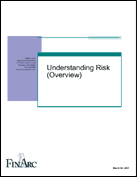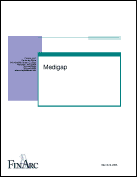






|
 |
FinArc offers the following articles and videos to the general public for educational and informational benefit. Please contact us to learn more about these topics or to discuss alternative financial interests.
1) Collecting Benefits Early
2) Understanding Risk
3) How Does FinArc Manage Capital Gains?
4) What’s the Buzz about Long Term Care
5) Performance Measurement
6) Buying Supplemental Health Insurance Medigap
7) Reevaluate Your 401(k) When You Change Jobs
8) Social Media Regulatory Compliance for Investment Advisor
9) Keeping Emotions in Check While Investing
10) Is Buying Investment Research Worth the Price?
11) Financial Tips for People Between Jobs
Collecting Benefits Early
If you've earned enough credits to do so, you can start collecting Social Security benefits as early as age 62. The number of credits you need is determined by the year you were born. If you were born in 1929 or later, you need 40 credits (or about 10 years of work). If you were born before 1929, you need fewer credits.
Starting early may sound great, but there's a catch: If you take early retirement, your benefits will be permanently reduced based on the number of months you will receive checks before you reach full retirement age. If your full retirement age is 65, the reduction for starting your Social Security at age 62 is about 20 percent; at age 63, it is about 13 and 1/3 percent; and at age 64, it is about six and 2/3 percent. Here is the chart that shows the full retirement ages:
| Year of Birth |
Full Retirement Age |
| 1937 or earlier |
65 |
| 1938 |
65 and 2 months |
| 1939 |
65 and 4 months |
| 1940 |
65 and 6 months |
| 1941 |
65 and 8 months |
| 1942 |
65 and 10 months |
| 1943-1954 |
66 |
| 1955 |
66 and 2 months |
| 1956 |
66 and 4 months |
| 1957 |
66 and 6 months |
| 1958 |
66 and 8 months |
| 1959 |
66 and 10 months |
| 1960 and later |
67 |
Source: Social Security Administration
Consider the following in your decision making - the earlier you receive benefits, the less money you will receive on a monthly basis. If you begin taking Social Security early, your payments will be reduced by approximately 1/2% for each month you take benefits before your full retirement age. For example, if you begin taking social security at age 62 and your full retirement age is 65, your payments will be reduced by 20%. The number decreases to 13 1⁄2 % and 61/2% at ages 63 and 64 respectively. If you enjoy your job and/or are able to work beyond your full retirement age (prior to age 70), you stand to get credit. The following chart shows what you might gain by delaying payments.
| Year of Birth |
Yearly Rate of Increase
|
| 1917-1924 |
3% |
| 1925-1926 |
3.5% |
| 1927-1928 |
4% |
| 1929-1930 |
4.5% |
| 1931-1932 |
5% |
| 1933-1934 |
5.5% |
| 1935-1936 |
6% |
| 1937-1938 |
6.5% |
| 1939-1940 |
7% |
| 1941-1942 |
7.5% |
| 1943 or later |
8% |
Source: Social Security Administration
You can find out more about the effects of early or delayed retirement by visiting the Social Security website at http://www.ssa.gov/. You can also review your Social Security statement that you receive in the mail.
When examining your financial situation, determine what your cash needs are. If you have sufficient resources and can delay payments, it would most likely be in your best interest to do so. However, if you are cash strapped and are uncomfortable or uncertain about your financial future, you may need to consider taking payments earlier.
Life expectancy is another consideration. One of the reasons the full retirement age has increased is due to the fact that people are living longer. And when people live longer, the length of time for which one needs financial security increases. By postponing payments, your monthly checks will be larger.
Of course, if you take benefits early, you will receive checks for a longer period of time. This brings into question, at what age will one break-even and come out ahead when delaying benefit payments. According to the Social Security Administration, the following are break-even ages for someone with monthly benefits at ages 62, 66 and 70 of $1,346, $1786 and $2,358 respectively.
age 62 vs. age 66 - Break-even age is 78
age 62 vs. age 70 - Break-even age is 80, 6 mos. age 66 vs. age 70 - Break-even age is 82, 5 mos.
If your life expectancy is beyond the break-even age, it makes more sense to delay your payments.
Other areas of consideration are whether or not you have a spouse and his/her employment history, in addition to taking payments while still earning income. The latter may reduce your benefit.
[back to top]
Understanding Risk
(PDF)

How Does FinArc Manage Capital Gains?
For capital gains management, we do our analysis each year the week after Thanksgiving. Of course we keep an eye on taxes during the year. It is impossible to forecast where the market will be at that time, so I can't comment on tax management. We do this automatically for all clients, so they don't have to worry about it. If you have a taxable event outside of this portfolio, please let us know to take it into account (selling a house is the most common occurrence).
[back to top]
What’s the Buzz about Long Term Care
Susie Caspar, Senior Long Term Care Specialist
Here’s another item for your “to do” list: plan for long term care needs. Have you had a family member or friend who had a prolonged illness, catastrophic accident or failing health? Who paid for their care and where was it provided? Was it stressful?
Long term care is one of the largest risks most Americans face. It is important to recognize the possibility that you or a loved one will need long term care.
- Some 42% of Americans who reach the age of 70 will need long term care. PR Newswire 5/19/01
- 40% of those needing long term care are under age 65. Submitted Testimony of Robert B. Blancato, Executive Director, 1995 White House Conference on Aging to U.S. Senate
- The average cost of a nursing home stay in the greater Boston area ranges from $73,000 - $110,000 per year. If the average length of time a person has Alzheimer’s is 8-10 years, this translates to $1 million in today’s dollars!
A long term illness could wipe out your life savings and impoverish your healthy spouse. Sobering facts, to be sure, yet many of us stubbornly cling to the belief that we will never need long term care. Above all, this shows how vital it is that we become better educated. Most people buy long term care insurance for one of the following reasons:
- to protect their assets and preserve their inheritance for the beneficiaries of their choice
- to reduce the burden to their family – financially, emotionally, and physically, should they need LTC
- to allow them to receive care where they choose (usually at home), and to have an expert oversee their care services.
Your standard health/medical insurance does not cover long term care costs, nor does the government, unless you go on Medicaid or have separate LTC insurance. Unfortunately, Medicaid does not pay for daily home care, only for nursing home care. You lose the ability to choose where you receive your care if you rely on Medicaid. Quality of care in nursing homes heavily dependent on Medicaid financing may have lower standards. More importantly, will the government be able to pay for all the Baby Boomers?
Times have changed and family members are not always able to quit their jobs to care for a loved one. They may live too far away, or perhaps they too, have declining health. Long term care coverage used to provide only for nursing home care. The good news is that today, most people are using their long term care insurance to also pay for home care services. This means individuals with long term care insurance are choosing to receive quality care in the comfort of their own homes, surrounded by loved ones who are able to keep an eye on things.
When should you buy long term care insurance? Once you are over age 40, it is time to educate yourself about your options. You need to have reasonably good health, rates are based on your age, and the policy value grows each year. Simply stated, it doesn’t pay to wait. Compare the cost of long term care insurance premiums paid over 30 or 40 years to as little as one year in a nursing home, and you’ll see how valuable long term care insurance protection can be in terms of dollars and cents.
Susie Caspar, GE LTC is a Senior Long Term Care Specialist with GE. She can be reached at (508) 785-3559 or via email at
.
[back to top]
Performance Measurement
By Liv Nash, MBA, Client Service Liaison
For many investors, performance is looked at as merely a gain or loss. However, behind these numbers there are many factors; factors that are important for an investor to be aware of and to understand.
The simplest performance calculation compares the percentage change between an ending market value and a beginning market value for any given time period. This simple calculation, however, does not take into consideration deposits and/or withdrawals that may have occurred in the portfolio during the specified period. If the deposit or withdrawal is more than 10% of the value of the portfolio, the impact on performance could be significant.
More than any other influence, performance is affected by the asset allocation of a portfolio. Asset allocation refers to the mix of stocks, bonds and cash equivalents in a portfolio. This allocation is typically determined by a person’s risk tolerance, time horizon, age, income needs and asset level.
On average, an individual who is risk averse, older or has lower return needs will have a higher percentage of fixed income (bonds) and cash equivalents in his/her portfolio. Individuals who have a higher tolerance for risk, are younger, or may require more growth will tend to have a higher percentage of stock holdings. The assumption is that stocks carry more risk than fixed income instruments, and with more risk one can expect higher returns in up markets. Unfortunately, the opposite tends to be true when the market performs poorly.
Risk is measured by standard deviation, the volatility of returns around the average return. The more volatility, the higher the standard deviation, the greater the risk. Stocks with higher earnings growth will tend to rise and fall more than the market, however overall returns are typically higher with stocks than with other types of investments.
Beta is another measurement of risk. Beta is a stock’s sensitivity to movement of the whole market. The S&P 500 has a Beta of one. A stock with a Beta of 2.0 is two times more sensitive to market movements. For example, if the market rises by 5%, a stock with a Beta of 2.0 would be expected to increase by 10% (2 x 5%). If the market were to fall by the same amount, you would anticipate the stock to fall by 10%.
FinArc shows client portfolio performance vs. a given benchmark. Most domestic stock portfolios are measured against the S&P 500 as this index represents the 500 largest public companies in the United States. Portfolios that consist of fixed income instruments and/or foreign securities are measured against a combination of indices that may include the Lehman Government Credit Bond Index or Morgan Stanley EAFE (Europe, Australasia, Far East).
As we all know, performance numbers themselves leave a reader with a strong first impression. By providing an overview of the factors affecting performance measurement, these numbers can become more personalized as we consider that our own needs, desires and investments are all part of the equation.
[back to top]
Buying Supplemental Health Insurance Medigap
(PDF)

[ back to top]
Optimizing your Retirement Plan
Why changes in your employment status are the ideal time to reevaluate your investment options.
Job loss and career change are becoming an increasingly common fact of everyday life. Though these important life changes can be a source of anxiety, they represent a unique opportunity for investors to reconsider their investment options. For many Americans, investments in company-sponsored retirement plans like 401(k)s comprise a large percentage of their total retirement savings. When leaving a company, individuals often fail to consider both the opportunity and financial costs associated with leaving retirement assets in legacy company retirement accounts or rolling the assets into new employer 401k plans. Company retirement plans offer many benefits which investors, particularly those with minimal investment experience, find attractive. Features such as limited investment offerings and access to institutional level pricing on mutual funds helps to reduce confusion for the average employee, while providing access to investments that might not be obtainable otherwise. An additional advantage is that assets held in 401k plans are sometimes partially protected from lawsuits and bankruptcy proceedings, unlike assets held in IRAs.
However, leaving assets in former company sponsored plans, or rolling assets over into new employer plans, comes with drawbacks that many investors fail to recognize. First and foremost, investors are limited to the investment options available within the plan. If the mutual funds selected by the Plan Sponsor are less attractive than alternative options in the marketplace, investors often have minimal recourse and are forced to invest in sub-par offerings. In addition, many 401k plans are limited to major geographic areas and asset classes, preventing individuals from investing outside these pre-determined categories. Investors in company retirement plans also face the challenge of trying to determine the true cost of being a plan participant, which often includes plan management fees in addition to the underlying mutual fund fees. When you add in the increasingly common investment offerings like Target Date and Lifecycle funds which are “funds of funds,” investors are faced with a third layer of fees. In essence, all of these fees create a higher hurdle rate for individuals to overcome when attempting to achieve competitive returns.
Due to these drawbacks, rolling retirement assets into a Rollover IRA often makes sense. Rollover IRAs offer the latitude to invest across all asset classes and enable investors to use a variety of investment vehicles including mutual funds, individual stocks and bonds as well as ETFs. Rollover IRA accounts can be opened at any of the major brokerage firms, and unlike 401k plans, typically have no annual fee associated with them. For novice investors that don’t feel comfortable with the wide selection of investment offerings, utilizing the services of an investment advisor may make sense in order to ensure you build a portfolio which is in line with your risk tolerance and investment horizon.
So, if you are considering a career change or have lost your job, take advantage of the opportunity you have been afforded to assess your investment situation. If the mutual fund offerings in your current or legacy company 401(k) are inadequate, consider expanding your investment options by utilizing a Rollover IRA. The process of rolling retirement assets into a Rollover IRA is a simple one, and may just be one of the best investment moves you make.
By Liam M. Timmons, Associate Analyst
[back to top]
Social Media Regulatory Compliance for a Registered Investment Advisor
Matthew C. Slaney, CFA, was interviewed by Financial Advisor Magazine on the subject of compliance for social media. Here is a link to the article.
[back to top]
Keeping Emotions in Check While Investing
Matthew Slaney, CFA, was featured on the Wall Street Journal's website in an article about the value financial advisors can provide to their clients. The focus is on helping clients invest successfully, particularly at times when emotions can lead to damaging investment decisions.
[back to top]
Is Buying Investment Research Worth the Price?
Matthew Slaney, CFA was featured in Barron's article 'Getting What You Pay For'. Despite free online investment material, financial advisors are still paying for good information. Why? Mr. Slaney explained how outside research can offer FinArc's analysts additional perspectives and free up time for deeper research into the most important issues. Mr. Slaney also said "Our motivations are aligned with our clients and using independent research firms fits that sensibility." The article concludes that if good information really makes for good markets, we may all be a little better off. You can read the entire article online at Barron's.
[back to top]
Financial Tips for People Between Jobs
|
 |





